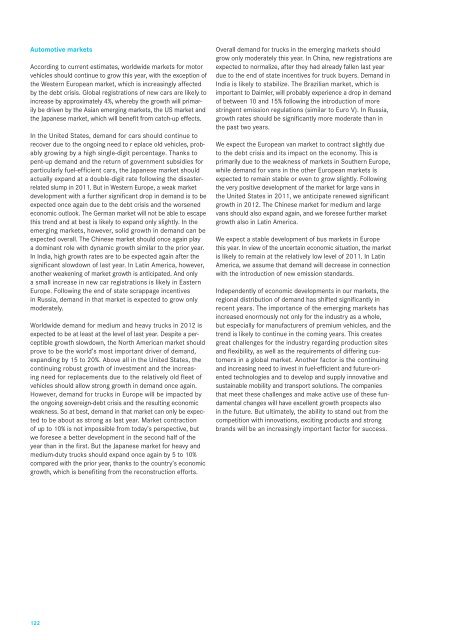Daimler Annual Report 2011 - Alle jaarverslagen
Daimler Annual Report 2011 - Alle jaarverslagen
Daimler Annual Report 2011 - Alle jaarverslagen
You also want an ePaper? Increase the reach of your titles
YUMPU automatically turns print PDFs into web optimized ePapers that Google loves.
Automotive markets<br />
According to current estimates, worldwide markets for motor<br />
vehicles should continue to grow this year, with the exception of<br />
the Western European market, which is increasingly affected<br />
by the debt crisis. Global registrations of new cars are likely to<br />
increase by approximately 4%, whereby the growth will primar <br />
ily be driven by the Asian emerging markets, the US market and<br />
the Japanese market, which will benefit from catch-up effects.<br />
In the United States, demand for cars should continue to<br />
recover due to the ongoing need to r eplace old vehicles, probably<br />
growing by a high single-digit percentage. Thanks to<br />
pent-up demand and the return of government subsidies for<br />
particularly fuel-efficient cars, the Japanese market should<br />
actually expand at a double-digit rate following the disasterrelated<br />
slump in <strong>2011</strong>. But in Western Europe, a weak market<br />
development with a further significant drop in demand is to be<br />
expected once again due to the debt crisis and the worsened<br />
economic outlook. The German market will not be able to escape<br />
this trend and at best is likely to expand only slightly. In the<br />
emerging markets, however, solid growth in demand can be<br />
expected overall. The Chinese market should once again play<br />
a dominant role with dynamic growth similar to the prior year.<br />
In India, high growth rates are to be expected again after the<br />
significant slowdown of last year. In Latin America, however,<br />
another weakening of market growth is anticipated. And only<br />
a small increase in new car registrations is likely in Eastern<br />
Europe. Following the end of state scrappage incentives<br />
in Russia, demand in that market is expected to grow only<br />
moderately.<br />
Worldwide demand for medium and heavy trucks in 2012 is<br />
expected to be at least at the level of last year. Despite a perceptible<br />
growth slowdown, the North American market should<br />
prove to be the world’s most important driver of demand,<br />
expanding by 15 to 20%. Above all in the United States, the<br />
continuing robust growth of investment and the increasing<br />
need for replacements due to the relatively old fleet of<br />
vehicles should allow strong growth in demand once again.<br />
However, demand for trucks in Europe will be impacted by<br />
the ongoing sovereign-debt crisis and the resulting economic<br />
weakness. So at best, demand in that market can only be expected<br />
to be about as strong as last year. Market contraction<br />
of up to 10% is not impossible from today’s perspective, but<br />
we foresee a better development in the second half of the<br />
year than in the first. But the Japanese market for heavy and<br />
medium-duty trucks should expand once again by 5 to 10%<br />
compared with the prior year, thanks to the country’s economic<br />
growth, which is benefiting from the reconstruction efforts.<br />
Overall demand for trucks in the emerging markets should<br />
grow only moderately this year. In China, new registrations are<br />
expected to normalize, after they had already fallen last year<br />
due to the end of state incentives for truck buyers. Demand in<br />
India is likely to stabilize. The Brazilian market, which is<br />
important to <strong>Daimler</strong>, will probably experience a drop in demand<br />
of between 10 and 15% following the introduction of more<br />
stringent emission regulations (similar to Euro V). In Russia,<br />
growth rates should be significantly more moderate than in<br />
the past two years.<br />
We expect the European van market to contract slightly due<br />
to the debt crisis and its impact on the economy. This is<br />
primarily due to the weakness of markets in Southern Europe,<br />
while demand for vans in the other European markets is<br />
expected to remain stable or even to grow slightly. Following<br />
the very positive development of the market for large vans in<br />
the United States in <strong>2011</strong>, we anticipate renewed significant<br />
growth in 2012. The Chinese market for medium and large<br />
vans should also expand again, and we foresee further market<br />
growth also in Latin America.<br />
We expect a stable development of bus markets in Europe<br />
this year. In view of the uncertain economic situation, the market<br />
is likely to remain at the relatively low level of <strong>2011</strong>. In Latin<br />
America, we assume that demand will decrease in connection<br />
with the introduction of new emission standards.<br />
Independently of economic developments in our markets, the<br />
regional distribution of demand has shifted significantly in<br />
recent years. The importance of the emerging markets has<br />
increased enormously not only for the industry as a whole,<br />
but especially for manufacturers of premium vehicles, and the<br />
trend is likely to continue in the coming years. This creates<br />
great challenges for the industry regarding production sites<br />
and flexibility, as well as the requirements of differing customers<br />
in a global market. Another factor is the continuing<br />
and increasing need to invest in fuel-efficient and future-oriented<br />
technologies and to develop and supply innovative and<br />
sustainable mobility and transport solutions. The companies<br />
that meet these challenges and make active use of these fundamental<br />
changes will have excellent growth prospects also<br />
in the future. But ultimately, the ability to stand out from the<br />
competition with innovations, exciting products and strong<br />
brands will be an increasingly important factor for success.<br />
122

















